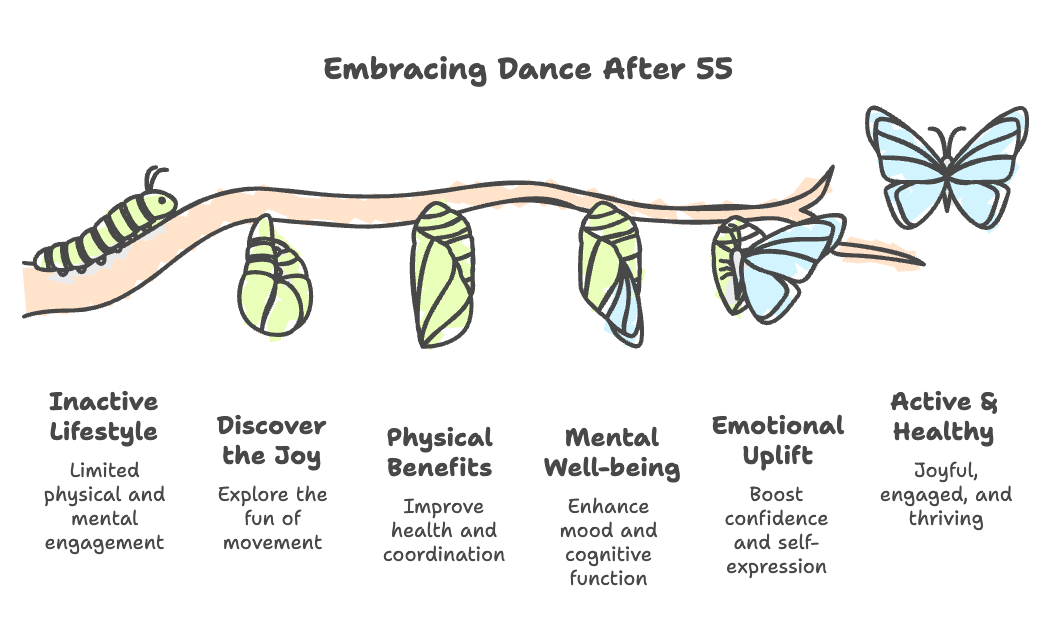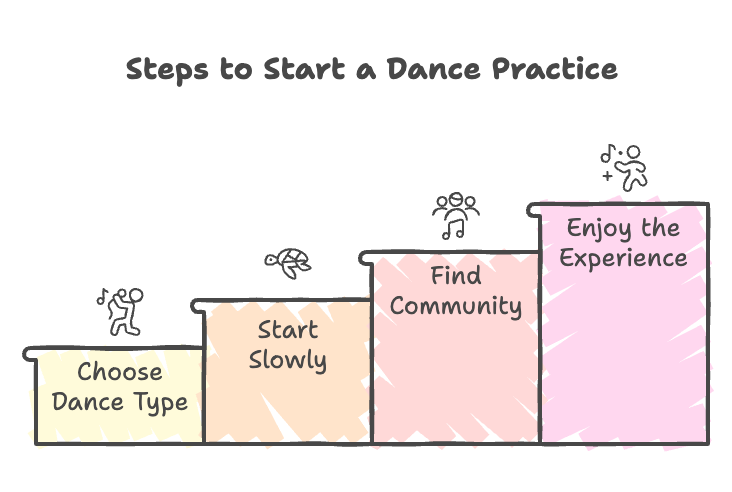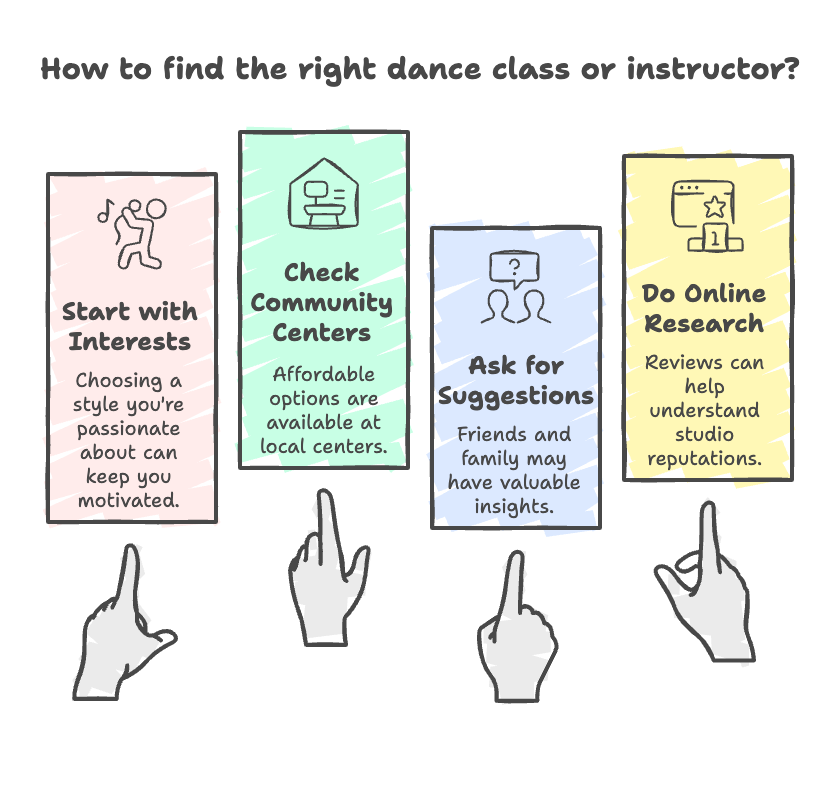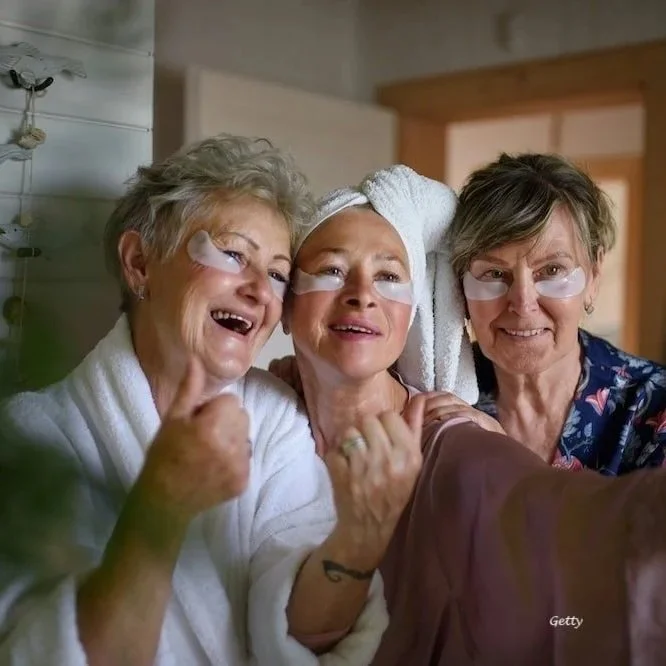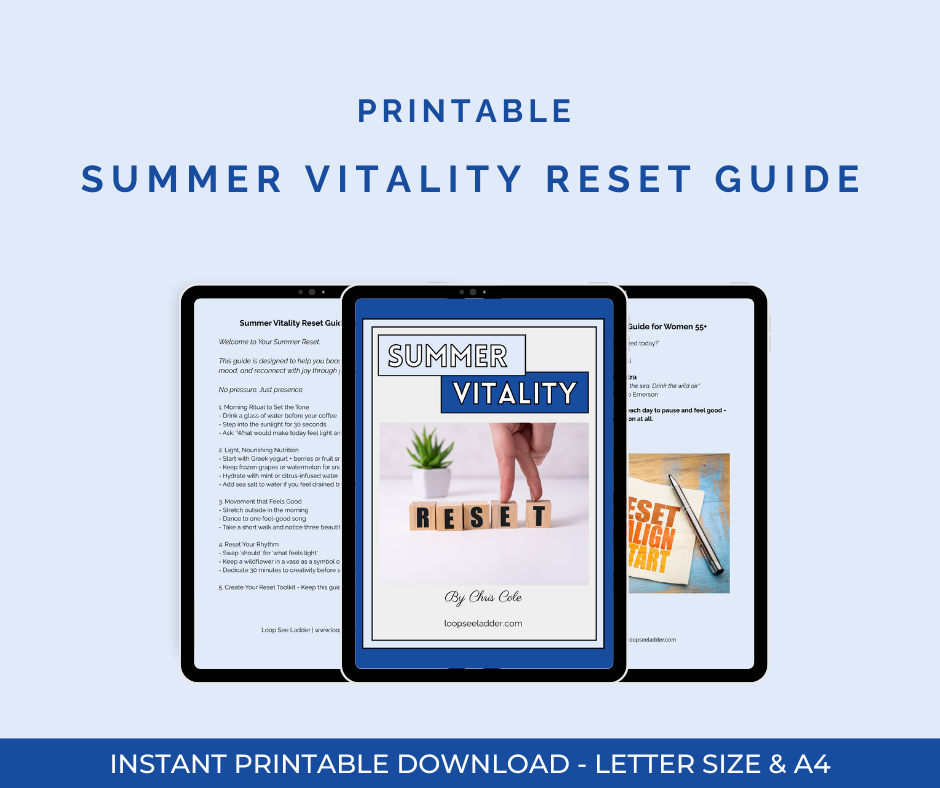Why Women Over 55 Should Dance Like No One Is Watching
It's essential to find ways to stay active and healthy, both physically and mentally.
And what better way to do that than dance? Dance like no one is watching.
Dancing like no one is looking is an excellent idea for women over 55 to support themselves in living their best lives with passion and joy and to enhance mental and emotional well-being.
Summary: In this post, you invite women aged 55 and over to embrace movement, joy, and self-expression through the metaphor (and possibility) of dancing like no one is watching. You explore how self-consciousness, fear of judgment, and internalized “shoulds” often quiet the impulse to play, move, create and live boldly. By choosing to dance—literally or figuratively—you reclaim your body, your freedom, your voice. You encourage readers to lean into what lights them up, to move even when the steps aren’t perfect, and to remember that the music of life is still playing. The message: at this stage of life, you still have rhythm, you still have movement, and you still deserve to dance with abandon. Dance like no one is watching.
A Preamble
As we age, it's essential to find ways to stay active and healthy, both physically and mentally.
And what better way to do that than dance? Dance like no one is watching.
Dancing can offer many benefits for women over 55, from improving physical health to enhancing mental and emotional well-being.
In this article, we'll explore why dancing like nobody’s watching is an excellent idea for women over 55.
From the physical benefits to tips for getting started, we'll provide a roadmap for anyone looking to incorporate dance into their lives.
So, get your dancing shoes on and get ready to discover the joy of movement!
As we age, it's essential to find ways to stay active and healthy, both physically and mentally.
And what better way to do that than dance? Dance like no one is watching.
Physical Benefits of Dancing
Dancing not only provides a fun and social outlet but also offers physical benefits for women over 55.
Regular dancing can improve balance and coordination, increase muscular strength and endurance, and promote cardiovascular health.
As we age, our bodies naturally experience a decline in muscle mass and bone density, making it crucial to engage in weight-bearing activities, such as dancing, to prevent falls and fractures.
Additionally, dancing can be a low-impact exercise that reduces joint pain and stiffness while improving flexibility.
Moving to music can also boost our mood and mental well-being.
So, next time you feel like staying in, consider turning up the music and letting your body move freely.
Dancing like no one is looking may be the key to a healthier and happier you. Dance as if no one is looking.
Dancing not only provides a fun and social outlet but also offers physical benefits for women over 55.
Regular dancing can improve balance and coordination, increase muscular strength and endurance, and promote cardiovascular health.
Mental Benefits of Dancing - Dance Like No One Is Watching
Moving to music not only benefits our physical health but also provides numerous mental benefits.
When we dance, our brains release endorphins, which are chemicals that promote feelings of happiness and well-being.
This can reduce stress, anxiety, and even symptoms of depression.
Dancing also engages our brains, enhancing cognitive function, memory, and focus.
For women over 55, dancing can be a great way to stay socially connected and mentally stimulated.
It can also provide a sense of accomplishment and self-confidence as we learn new steps and master different dance styles.
By incorporating dance into our lives, we can improve our overall quality of life and maintain a positive outlook on aging.
So, don't be afraid to let loose on the dance floor and enjoy the mental benefits of dancing. Dance like nobody’s watching. Sing like nobody’s listening.
Moving to music not only benefits our physical health but also provides numerous mental benefits.
When we dance, our brains release endorphins, which are chemicals that promote feelings of happiness and well-being.
Emotional Benefits of Dancing
Dancing benefits our physical and mental health and positively impacts our emotional well-being.
Through dance, we can express ourselves creatively and connect with others on a deeper level.
The music and movement allow us to let go of any stress or negative emotions we may be holding onto and provide an avenue for release.
For women over 55, dancing can be particularly beneficial as it allows us to explore new facets of our identities and connect with our inner selves.
It can help us rediscover our passions and ignite a sense of purpose.
Additionally, dancing with others can create a sense of community and belonging, which is especially important as we age and experience isolation.
Dancing benefits our physical and mental health and positively impacts our emotional well-being.
Through dance, we can express ourselves creatively and connect with others on a deeper level.
Tips for Starting a Dance Practice
If you're ready to start your dance practice, some tips can help you get started.
First, it's essential to choose a type of dance you enjoy. This will keep you motivated and excited to continue practicing. You can try different types of dance, such as ballroom, salsa, or ballet, to see which ones resonate with you the most.
Another tip is to start slowly and gradually build up your dance practice. Don't push yourself too hard or expect to become an expert immediately. Take it one step at a time, and be patient with yourself.
Finding a supportive community of dancers who can encourage and inspire you along the way is also helpful. You can do this by joining a dance class or finding a group of like-minded individuals who share your passion for dance.
Above all, remember that dancing should be a joyful and fulfilling experience.
Don't worry about being perfect or getting everything right. Just focus on enjoying the music, moving your body, and expressing yourself through dance. Dance like no one is watching.
By following these tips, you can confidently start your dance practice and create a fulfilling and rewarding experience that will enhance your physical, mental, and emotional health.
If you're ready to start your dance practice, some tips can help you get started.
Don't worry about being perfect or getting everything right. Just focus on enjoying the music, moving your body, and expressing yourself through dance. Dance like nobody is watching.
Finding the Right Class or Instructor
Finding the right class or instructor can make all the difference when starting a dance practice.
But with so many options, it can be challenging to know where to begin.
Here are some tips to help you find the perfect fit:
Start with your interests: What kind of dance style appeals most? Whether it's ballroom, salsa, or hip hop, starting with a style you're passionate about can keep you motivated and excited to learn.
Check your local community centers. Many community centers offer dance classes at reasonable prices, making them affordable options for those on a budget.
Ask for recommendations: Contact friends or family members who have taken dance classes and ask for their recommendations. They may have valuable insights into which instructors or classes are the best in your area.
Do your research: Look up local dance studios and read online reviews to find those with a good reputation.
Finding the right class or instructor may take trial and error, but it is worth it if you can find a fulfilling and enjoyable practice.
Finding the right class or instructor can make all the difference when starting a dance practice.
Finding the right class or instructor may take trial and error, but it is worth it if you can find a fulfilling and enjoyable practice.
Overcoming Common Obstacles
While dancing can be a joyful experience, it's essential to acknowledge that obstacles may arise along the way.
Here are some common obstacles you may face as you begin your dance journey and how to overcome them:
1. Self-doubt: It's natural to feel self-conscious when starting something new, especially when doing it in front of others. But don't let your fears hold you back! Remember that everyone starts somewhere and that every dancer has their unique style. Let go of perfectionism and focus on the joy of moving your body.
2. Physical limitations: As we age, our bodies may not move as quickly as they used to. But that doesn't mean you can't dance! Talk to your instructor about any physical limitations; they will likely suggest modifications or alternative movements that will work for you.
3. Financial constraints: Dance classes and performances can be expensive, but don't let money hinder your passion. Look for community programs or senior discounts that can help make dance more affordable.
4. Lack of time: Life can get busy, but don't let that stop you from dancing! Look for classes that fit your schedule, or consider practicing at home with online videos or tutorials.
By acknowledging these obstacles and finding ways to overcome them, you can continue to dance like no one is looking and experience its many physical, emotional, and social benefits. So don't be afraid to take that first step and start moving! Dance like nobody’s looking.
While dancing can be a joyful experience, it's essential to acknowledge that obstacles may arise along the way.
Here are some common obstacles you may face as you begin your dance journey and how to overcome them:
Conclusion
Dancing is a fantastic activity for women over 55.
It not only improves physical fitness but also provides mental and emotional benefits.
Incorporating dance into your lifestyle can reduce stress, boost your confidence, and help you connect with others in your community.
Remember to start small, find a suitable class or instructor, and push past common obstacles.
So go ahead, put on some music, and dance like no one is watching - your mind and body will thank you.
As the famous philosopher Friedrich Nietzsche once said, "We should consider every day lost on which we have not danced at least once."
Dancing is a fantastic activity for women over 55.
It not only improves physical fitness but also provides mental and emotional benefits.
A Challenge For You:
How do you want to dance and move your body? Decide on one way to try.
Make a firm plan to learn to dance like no one is watching.
Carry out that plan and experience the joy of learning and movement.
Celebrate your victories.
You are amazing!
From The Topeka Capital-Journal - Connie Mason Michaelis: Dancing like nobody is watching works on many levels, including aging and exercise
From Inspired - Eileen Mackenzie: A Time to Dance
FAQ
Q: What does “dance like no one is watching” mean here?
A: It means letting go of the inner critic, the fear of appearance, the need for perfection or approval, and simply moving, expressing, living as your true self, even if others are present or not.
Q: Why is this concept especially relevant for women over 55?
A: Because at this stage, many women face transitions: bodies change, roles shift, time opens up, old energies carry over. The invitation to “dance” is a creative metaphor for stepping into this next chapter with freshness, courage and freedom—rather than shrinking, hiding or slowing purely out of caution.
Q: What kinds of “dancing” (literal or metaphorical) might this include?
A: The post might invite:
Getting up and literally dancing—whether in your living room, at a class, or at a social gathering.
Moving your body in new ways—walking a new route, trying a gentle dance or movement class, stretching, moving to music.
Expressing yourself creatively in other forms—writing, art, singing, gardening, volunteering—anything where you allow yourself to loosen the “watcher” in you.
Saying yes to spontaneous moments of joy, fun or connection where you often say no.
Q: How can I begin if I feel self-conscious or “too old” to dance?
A: The post suggests:
Start small and low-risk: turn on a favourite song at home, move in your own space, no audience.
Shift the focus from “looks good” to “feels good”: ask yourself how movement feels in your body rather than how it appears.
Accept imperfection: stumbling, laughing, pausing—all part of the dance. The magic is in showing up.
Invite a friend, or go solo: sometimes moving with no expectation is most freeing.
Reflect afterwards: how did it feel? What changed inside? Use that as fuel for next time.
Q: What outcomes can I expect if I embrace this practice?
A: You may notice: more lightness in your body, a quieting of the inner critic, more willingness to try new things, a greater sense of aliveness and joy. You may also feel more connected to your body, more present in your days, and more open to the possibilities of this chapter rather than waiting for “the right moment”.
👉 I thoughtfully use AI tools to polish my writing, but every story comes from my lived experience.


